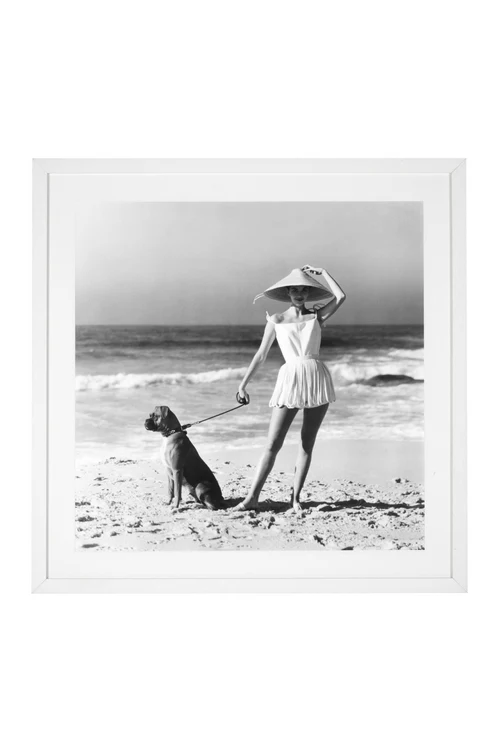A Tribute to Timeless Elegance!
The Eichholtz Vogue 1956 Black and White Print stands as a testament to the enduring allure of vintage fashion photography. This captivating image, captured during a golden era of style, has become a sought-after piece for interior designers and art enthusiasts alike.
It’s ability to elevate the aesthetic of any living space is unparalleled, making it a popular choice for those who appreciate the intersection of fashion, art, and design.
The Legacy of Eichholtz and Vogue
Eichholtz, the renowned Dutch luxury furniture and accessories brand, has long been synonymous with sophisticated home decor. Their curated collection of wall art includes timeless images that have stood the test of time, and the Vogue 1956 print is undoubtedly one of their standout offerings.
The 1950s marked a pivotal era in fashion history. This decade saw the emergence of new silhouettes, the pervasive influence of Hollywood glamour, and the rise of fashion photography as a respected art form.
Vogue magazine, already established as the leading voice in the fashion world, played a crucial role in documenting and shaping these trends.
Under the leadership of editor-in-chief Jessica Daves, Vogue in 1956 was at the forefront of showcasing the work of emerging designers and photographers. The magazine was instrumental in popularizing the “New Look” silhouette introduced by Christian Dior, which defined much of 1950s fashion with it’s nipped-in waists and full skirts.
The Eichholtz Vogue 1956 print encapsulates the essence of this transformative period, freezing a moment of haute couture in time. It represents a moment when fashion was undergoing a significant transformation, and Vogue was there to document and influence these changes.
Design Elements and Composition
At first glance, the Eichholtz Vogue 1956 print is a study in contrasts. The black and white photography lends an air of classic sophistication to the image, allowing viewers to focus on the composition and intricate details without the distraction of color.
The subject of the photograph is likely a model wearing a haute couture creation from a leading designer of the time. The dress itself would have been a showstopper, with it’s intricate details and dramatic silhouette typical of 1950s evening wear.
The photographer has masterfully captured the model in a pose that emphasizes the gown’s structure and flow, creating a sense of movement and grace within a static image. This careful attention to lighting, the dramatic pose of the model, and the emphasis on the garment’s silhouette are all hallmarks of the high-fashion photography style that was developing during this period.
The background of the print is intentionally minimalist, drawing all attention to the model and her attire. This stark contrast between the detailed gown and the plain backdrop is a hallmark of fashion photography from this period, allowing the clothing to take center stage.
The Importance of Black and White
The decision to present this image in black and white is not merely a nod to the era in which it was taken, but a deliberate artistic choice that enhances it’s impact. Black and white photography has a unique ability to convey mood and emotion, stripping away the distractions of color to focus on form, texture, and light.
In the context of the Eichholtz Vogue 1956 print, the monochromatic palette emphasizes the dramatic lines of the gown, the play of light and shadow on the fabric, and the model’s pose. It creates a timeless quality that transcends the specific year of it’s creation, allowing it to feel both vintage and contemporary simultaneously.
The use of black and white also adds a layer of sophistication and elegance to the image. It harks back to a time when fashion photography was still establishing itself as an art form, and photographers were experimenting with new techniques to capture the essence of haute couture.
The Photographers Behind Vogue
While the specific photographer of this 1956 Vogue image may not be known, it’s worth noting that Vogue worked with some of the most talented fashion photographers of the era. Names like Irving Penn, Richard Avedon, and Horst P.
Horst were regular contributors, each bringing their unique style to the pages of the magazine.
Irving Penn, for example, was known for his clean, minimalist approach to fashion photography. His images often featured models posed against plain backgrounds, much like the Eichholtz print.
Penn’s work helped to define the look of Vogue in the 1950s and beyond.
Richard Avedon, on the other hand, was famous for injecting movement and energy into his photographs. He often captured models in motion, creating dynamic images that brought the clothes to life.
Avedon’s work revolutionized fashion photography, moving it away from static, posed shots to more lively and spontaneous images.
Horst P. Horst, with his background in architecture, brought a strong sense of composition and form to his fashion photographs.
His images often featured dramatic lighting and sculptural poses, creating a sense of timeless elegance.
Regardless of which photographer captured this particular image, it’s clear that they were working at the height of their craft, creating an image that has stood the test of time and continues to captivate viewers decades later.
